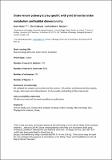| dc.contributor.author | Healy, Kevin | |
| dc.contributor.author | Carbone, Chris | |
| dc.contributor.author | Jackson, Andrew L. | |
| dc.date.accessioned | 2019-05-20T08:08:55Z | |
| dc.date.issued | 2019-01-07 | |
| dc.identifier.citation | Healy, Kevin, Carbone, Chris, & Jackson, Andrew L. (2019). Snake venom potency and yield are associated with prey-evolution, predator metabolism and habitat structure. Ecology Letters, 22(3), 527-537. doi: 10.1111/ele.13216 | en_IE |
| dc.identifier.issn | 1461-0248 | |
| dc.identifier.uri | http://hdl.handle.net/10379/15180 | |
| dc.description.abstract | Snake venom is well known for its ability to incapacitate and kill prey. Yet, potency and the amount of venom available varies greatly across species, ranging from the seemingly harmless to those capable of killing vast numbers of potential prey. This variation is poorly understood, with comparative approaches confounded by the use of atypical prey species as models to measure venom potency. Here, we account for such confounding issues by incorporating the phylogenetic similarity between a snake's diet and the species used to measure its potency. In a comparative analysis of 102 species we show that snake venom potency is generally prey‐specific. We also show that venom yields are lower in species occupying three dimensional environments and increases with body size corresponding to metabolic rate, but faster than predicted from increases in prey size. These results underline the importance of physiological and environmental factors in the evolution of predator traits. | en_IE |
| dc.description.sponsorship | We thank several people for useful discussions that have helped develop this project including Natalie Cooper, Yvonne Buckley, Deirdre McClean and the members of NERD club. This work was funded by Science Foundation Ireland (K.H) and the Earth and Natural Sciences Doctoral Studies Programme with the Higher Education Authority through the Programme for Research at Third Level Institutions, Cycle 5 (PRTLI‐5), and co‐funded by the European Regional Development Fund, and the Marie Curie Research Grants Scheme, grant (749594) (K.H.). We are grateful to Kevin Arbuckle and all the anonymous reviewers who provided very detailed and constructive comments on earlier versions. | en_IE |
| dc.format | application/pdf | en_IE |
| dc.language.iso | en | en_IE |
| dc.publisher | Wiley | en_IE |
| dc.relation.ispartof | Ecology Letters | en |
| dc.rights | Attribution-NonCommercial-NoDerivs 3.0 Ireland | |
| dc.rights.uri | https://creativecommons.org/licenses/by-nc-nd/3.0/ie/ | |
| dc.subject | Body size | en_IE |
| dc.subject | comparative analysis | en_IE |
| dc.subject | LD50 | en_IE |
| dc.subject | macroecology | en_IE |
| dc.subject | phylogenetic analysis | en_IE |
| dc.subject | scaling | en_IE |
| dc.subject | snake | en_IE |
| dc.subject | trophic ecology | en_IE |
| dc.subject | venom | en_IE |
| dc.title | Snake venom potency and yield are associated with prey‐evolution, predator metabolism and habitat structure | en_IE |
| dc.type | Article | en_IE |
| dc.date.updated | 2019-05-17T15:15:26Z | |
| dc.identifier.doi | 10.1111/ele.13216 | |
| dc.local.publishedsource | https://doi.org/10.1111/ele.13216 | |
| dc.description.peer-reviewed | peer-reviewed | |
| dc.contributor.funder | Science Foundation Ireland | en_IE |
| dc.contributor.funder | European Regional Development Fund | en_IE |
| dc.contributor.funder | Higher Education Authority, Programme for Research at Third Level Institutions, Cycle 5 (PRTLI‐5) | en_IE |
| dc.contributor.funder | National University of Ireland, Galway | en_IE |
| dc.description.embargo | 2020-01-07 | |
| dc.internal.rssid | 16255172 | |
| dc.local.contact | Kevin Healy. Email: kevin.healy@nuigalway.ie | |
| dc.local.copyrightchecked | Yes | |
| dc.local.version | SUBMITTED | |
| dcterms.project | info:eu-repo/grantAgreement/EC/H2020::MSCA-IF-EF-ST/749594/EU/Determining the drivers and importance of scavenging behaviors in a changing world using agent based modeling approaches./SCAVENGER | en_IE |
| nui.item.downloads | 481 | |


